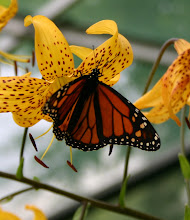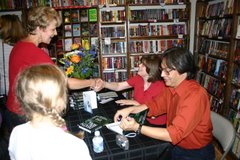 Becky Lovejoy is a volunteer at the Oregon Zoo in Portland, OR in their horticulture department. She’s loved animals and gardens all her life. It’s in her genes. Her ancestors were farmers, teachers, doctors, and gardeners. One imported trees and created quite the arboretum and another was instrumental in starting the Berlin Zoo. She’s taken naturalist training with Audubon, Jackson Bottom Wetlands and the Oregon Zoo, and is a Master Gardener. She’s also author of Zoo Tales, a wonderful collection of essays that captures the excitement of working behind the scenes at the Oregon Zoo.
Becky Lovejoy is a volunteer at the Oregon Zoo in Portland, OR in their horticulture department. She’s loved animals and gardens all her life. It’s in her genes. Her ancestors were farmers, teachers, doctors, and gardeners. One imported trees and created quite the arboretum and another was instrumental in starting the Berlin Zoo. She’s taken naturalist training with Audubon, Jackson Bottom Wetlands and the Oregon Zoo, and is a Master Gardener. She’s also author of Zoo Tales, a wonderful collection of essays that captures the excitement of working behind the scenes at the Oregon Zoo.What surprised you the most about volunteering at the Oregon Zoo?
What surprised me about volunteering at the zoo was how exciting it was and remains, every time I go through those iron gates and enter a world of wonder. As a person with many interests, a constant hunger for change, and an unquenchable curiosity for learning and seeing new stuff, I am always surprised at the anticipation that bubbles up when I drive up to the staff parking lot and hear the calls of the free-ranging peacocks and the morning shrieks of the siamangs.
What kind of opportunities are available to volunteers at the Oregon Zoo?
Volunteers have over 45 volunteer opportunities they can participate in. We can wash the zoo trains, help keepers feed and clean up after their charges, monitor larvae in the butterfly lab, make paper-mache deer for the tigers to tear apart, scuba dive to clean the sea lion pool, host activity tables at special events, enter data for the veterinary staff, help the exhibits crew design and maintain educational signs, dress up as an animal puppet, lead photography tours for adults and kids, or make up our own projects and pursue them. I’ve just initiated and finished phase one of inventorying our collection of hundreds of pelts, bones, eggs and artifacts that we loan out to volunteers to educate the public on zoo grounds.
What’s the question you get asked most often during your volunteer days?
“Where’s the bathroom,” or “where can I smoke?” -- Sorry it wasn’t something more profound like: “How can I make a definitive difference and assure a bountiful future for all the wildlife on this gorgeous planet?”
As with most zoos, people come to be entertained and while they are there we try to fulfill our purpose — to educate. Our mission is: “To inspire the community to create a better future for wildlife.” Right now we’ve joined nine other zoos and wildlife parks to spread the word about creating backyard habitats. I spend a lot of time on my knees weeding a hummingbird garden. People often ask me the names of plants and I try to educate them a little by saying that any red tubular flower is usually fair game for the hummers. If they can plant some of those in their yards, they’ll have wildlife that they can see from their windows. What seems like a casual question about a cardinal flower or hollyhock can start them on a whole new journey of planting gardens with wildlife in mind, thus sensitizing them to mankind’s place in the larger ecosystem and encouraging them to be good stewards of the land that’s in our care.
What’s an average day at the zoo is like for you?
I have an average 3-hour day, as I volunteer with the horticulture staff on Tuesdays and Fridays. I work with Phil, one of six horticulturists that each maintain about 7-8 acres of the zoo. Our area includes tigers, leopards, sea lions, otters, polar bears, sun bears, elk, lorikeets, the insect zoo, the fountain, a hummingbird garden, holding areas for plants, and various lengths of paths. We clean up after them, and haul debris to our compost area or to a roll-off where it’s composted off-site. Our herbivores create over 2,000 pounds of manure a day (!) which we compost and return to the grounds as ZooDo. This mulching helps us cut down on weeds, watering (our water bill was $60,000/month a few years ago!), and the need to fertilize.
Sometimes we do heavy work together — cutting down trees for browse (food for animals), removing dead or diseased trees or shrubs, swapping out climbing logs (we call them “furniture”) from exhibits, troubleshooting irrigation which often means digging deep and muddy holes looking for leaks and breaks, and clambering around in exhibits removing hazards or planting up areas with native plants. Blackberry vines that trail in the water of our sea lions could scratch their corneas so we cut them back regularly. Our new leopard loved her exhibit improvements so much that she carefully dug out all the sword ferns we put in for her. The poor sun bears gobbled up the cascara sagrada berries that dropped into their enclosure and found out why they’re known for their laxative effect! Yep, we cut down that tree once the worried keepers found out what was happening.
What keeps you coming back?
All the cool plastic toys I find in the foliage that I get to keep. So far I have a gorilla, elephant, dinosaur, baby binky, superball, plastic ring… Just kidding! I think what keeps me coming back is that planting or pruning makes such a big aesthetic difference in a small amount of time, and I feel like I’ve really done something significant when I finish a project. I enjoy the physicality of the work — climbing and crawling, sawing and snipping — and I like being behind-the-scenes instead of working directly with people for hours at a time. As an introvert, interpretive talking and working at crowded special events was draining to me but horticulture was invigorating.
Do you have a favorite animal?
Nah. They’re all great. I started with a crush on Lance, the slender-snouted crocodile. I did interpretive talks in the steamy tropical building that housed him and Morgan, his mate, during my first winter as a ZooGuide. It wasn’t that I was fond of reptiles — I just wanted to be warm. I loved the dinosaur-looking scales on his back, the spiny points on his thick tail, his conical teeth, his long claws, and that unblinking stare.
What’s an average day at the zoo is like for you?
I have an average 3-hour day, as I volunteer with the horticulture staff on Tuesdays and Fridays. I work with Phil, one of six horticulturists that each maintain about 7-8 acres of the zoo. Our area includes tigers, leopards, sea lions, otters, polar bears, sun bears, elk, lorikeets, the insect zoo, the fountain, a hummingbird garden, holding areas for plants, and various lengths of paths. We clean up after them, and haul debris to our compost area or to a roll-off where it’s composted off-site. Our herbivores create over 2,000 pounds of manure a day (!) which we compost and return to the grounds as ZooDo. This mulching helps us cut down on weeds, watering (our water bill was $60,000/month a few years ago!), and the need to fertilize.
Sometimes we do heavy work together — cutting down trees for browse (food for animals), removing dead or diseased trees or shrubs, swapping out climbing logs (we call them “furniture”) from exhibits, troubleshooting irrigation which often means digging deep and muddy holes looking for leaks and breaks, and clambering around in exhibits removing hazards or planting up areas with native plants. Blackberry vines that trail in the water of our sea lions could scratch their corneas so we cut them back regularly. Our new leopard loved her exhibit improvements so much that she carefully dug out all the sword ferns we put in for her. The poor sun bears gobbled up the cascara sagrada berries that dropped into their enclosure and found out why they’re known for their laxative effect! Yep, we cut down that tree once the worried keepers found out what was happening.
What keeps you coming back?
All the cool plastic toys I find in the foliage that I get to keep. So far I have a gorilla, elephant, dinosaur, baby binky, superball, plastic ring… Just kidding! I think what keeps me coming back is that planting or pruning makes such a big aesthetic difference in a small amount of time, and I feel like I’ve really done something significant when I finish a project. I enjoy the physicality of the work — climbing and crawling, sawing and snipping — and I like being behind-the-scenes instead of working directly with people for hours at a time. As an introvert, interpretive talking and working at crowded special events was draining to me but horticulture was invigorating.
Do you have a favorite animal?
Nah. They’re all great. I started with a crush on Lance, the slender-snouted crocodile. I did interpretive talks in the steamy tropical building that housed him and Morgan, his mate, during my first winter as a ZooGuide. It wasn’t that I was fond of reptiles — I just wanted to be warm. I loved the dinosaur-looking scales on his back, the spiny points on his thick tail, his conical teeth, his long claws, and that unblinking stare.
Summer finally came and fickle as the wind, I fell in love with Chendra. She’s our little Bornean elephant. She and the other three cows were commanded to lie on their sides for a bath. Her eyes rolled mischievously because she was right next to the rubber bucket with apples and yams. When the keepers were sudsing up the larger elephants, she uncurled her trunk and began feeling for the bucket. A keeper caught her at it and said sternly: “No trunk, Chendra!” She whipped the trunk back and curled it tightly like a cinnamon roll. Not a minute later she gave a little chirp and as if under its own volition, her trunk went exploring again to see what was in the bucket. I got to stroke the wiry hairs on her head, and smell that alfalfa-elephant smell so characteristic of pachyderms. What’s not to love?
 I think my big romance is now with Gus and Julius, our Steller sea lions. I’ve seen them idly scratching with a flipper on a hot summer day, stretching noses up and over to touch their backs in amazing displays of yogic flexibility, turning endless graceful flips that make us lean on the glass in the underwater viewing area to get closer to them, and have tiptoed past their pool late at night to see stars sprinkle down on their sleeping forms floating together on the water’s surface. The sea lions are magnificent animals, and bring up in me a pain in my chest as well as a sweet longing to do anything I can to give these creatures a good life.
I think my big romance is now with Gus and Julius, our Steller sea lions. I’ve seen them idly scratching with a flipper on a hot summer day, stretching noses up and over to touch their backs in amazing displays of yogic flexibility, turning endless graceful flips that make us lean on the glass in the underwater viewing area to get closer to them, and have tiptoed past their pool late at night to see stars sprinkle down on their sleeping forms floating together on the water’s surface. The sea lions are magnificent animals, and bring up in me a pain in my chest as well as a sweet longing to do anything I can to give these creatures a good life.You’ve written a book about your experiences at the Oregon Zoo. What inspired you?
A little over a year ago, my mom innocently handed me John Sedgwick’s book: The Peaceful Kingdom: A Year in the Life of America’s Oldest Zoo. What fun! I figured I could write something like it and my imagination took off. A month later I was on my hands and knees in the snowy owl exhibit. A stray conversation with a zoo visitor and a thoughtful exchange of stares with an owl gave me insights that compelled me to write. Imagination and insight are well and good, but it took one last encounter to push me over the edge to commit and write an entire book. I became a “keeper talk” groupie, listening to the scheduled talks in the summer and pestering the keepers with questions. Jeb Barsh, one of our elephant keepers, gave an inspiring talk that said our generation might be the last one to see elephants in the wild. It was an “ah ha” moment for me. It brought home how critical our caring and stewardship is to endangered animals in zoos and in the wild, and I now had inspiration — this is important work and there is no time to lose.
My goal for this book is to bring you closer to the life before you. Breathe some of the same air that whooshes out of the nostrils of a Steller sea lion as he surfaces to breathe, watch a 12,000 pound elephant delicately pick sunflower seeds up with his trunk, and feel the air from the wingtips of a Harris hawk as she flies low overhead on her way to the stage at the bird show. My wish for you is to be inspired to love and protect those you meet at a zoo or in these pages. I hope you’ll feel connected to the primates who look and act so much like you, but also reach out to the poison dart frogs, the buckeye butterfly, and the saddle-bill stork, and find the heart in them that beats with a similar rhythm to yours.
Thanks Becky! You can order “Zoo Tales” directly from Becky. The cost is $14.95 plus $3.55 shipping. Contact Becky at la-beck@juno.com for ordering information.




No comments:
Post a Comment